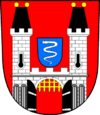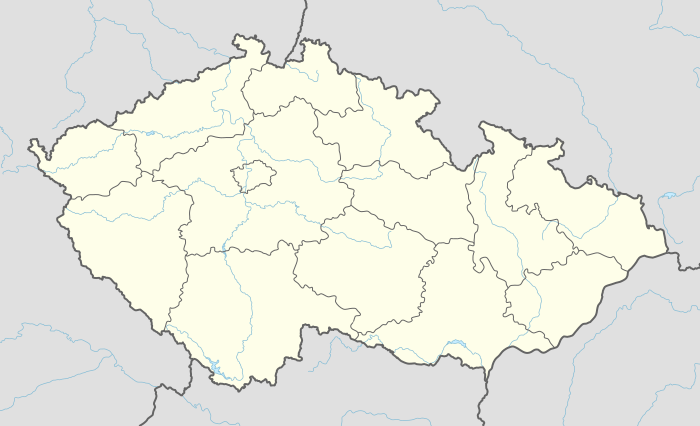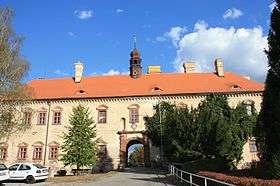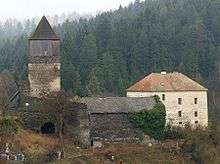Rataje nad Sázavou
Rataje nad Sázavou (German: Rattay; Ratais an der Sasau) is a market town in the Central Bohemian Region, Czech Republic, 27 km southwest of Kutná Hora and 6 km southeast of Sázava. It lies on the Sázava River.
Rataje nad Sázavou | |
|---|---|
Market Town | |
 Aerial view of Rataje | |
 Coat of arms | |
 Rataje nad Sázavou Location in the Czech Republic | |
| Coordinates: 49°50′45″N 14°57′47″E | |
| Country | Czech Republic |
| Region | Central Bohemian |
| District | Kutná Hora |
| First mentioned | 1156 |
| Government | |
| • Mayor | Luboš Kubát |
| Area | |
| • Total | 13.28 km2 (5.13 sq mi) |
| Elevation | 383 m (1,257 ft) |
| Population (2017)[1] | |
| • Total | 527 |
| • Density | 40/km2 (100/sq mi) |
| Time zone | UTC+1 (CET) |
| • Summer (DST) | UTC+2 (CEST) |
| Postal code | 285 07 |
| Website | www.obecrataje.cz |

History
The first written record of Rataje nad Sázavou dates back to 1156. It acknowledges that Rataje existed as a stronghold and market place. There are not any written reports about the exact date of its origin but it was probably about 946.
A castle, partly brick, partly wooden was founded on the place of the current castle in the middle of the 10th century. The castle was built as a border fortress of the Zlic region. This was proved by finding bronze and ceramic ornaments from 1890 when a road around the castle was built.
Rataje was rebuilt after a large fire in the middle of the 13th century. It was the property of the king at that time. John of Luxembourg gave Rataje to Henry of Lipa. The lords of Lipa also built a lower castle called Pirkštejn. Hynek Ptacek of Lipa and Pirkštejn gained Rataje in 1420. He was the highest hofmeister and münzmeister of the Bohemian kingdom, an administrator of the royal towns including Kutna Hora and a guardian of the future king, Jiri of Podebrady. This is the most important holder of Rataje and is buried in the family tomb in the local church.
Many noble families owned Rataje later on. For example, Ladislav, Vaclav and Jan of Malešice started the reconstruction of the Renaissance part of the chateau in the era from 1531 to 1579. In 1656 William Francis of Talmberk started the reconstruction of the entire chateau and his son Frantisek Maxmilian Leopold finished it. Rataje was held by the Liechtenstein family from 1772 to 1919. The municipality of Rataje bought the chateau in 1933 and placed a municipal office, post office, police station and school there.
Although the village once had several hotels these are now largely closed as of 2016.
Sights
- The Pirkštejn Castle which is now closed was first mentioned in 1366. The castle is approachable by a brick bridge, a medieval tower is on the southeast and a palace converted into a rectory is on the west side.
- Rataje Castle now comprises three parts: northern Gothic, southern Renaissance and western Baroque. There is a post office, municipal office and the Museum of Central Posazavi in the castle.
- The church of St. Matthew was built in the years 1675-1691 according to the plans of Andrew de Guarde.
- The chapel of St. Anthony near the road to Sazava.
- The chapel of St. Wenceslas.
Notable people
- John Francis Christopher of Talmberk, a bishop of Hradec Králové (1644-1698)
- Jan Peka, an ice-hockey goalkeeper (1894-1985)
- Antonín Vojtíšek, a music composer (1771-1820)
Transport
There are two railway tracks (014 and 212) and four railway stations: Rataje n. Sáz., Rataje n. Sáz. předměstí, Rataje n. Sáz. zastavka, Rataje n. Sáz. Ivaň.
In popular culture
The town's 1403 recreation was prominently featured in Czech role-playing game Kingdom Come: Deliverance.[6]
References
- "Population of Municipalities - 1 January 2017". CZSO. Retrieved 15 April 2018.
- "Pirkštejn – Pirkenštejn". www.hrady-zriceniny.cz. Retrieved 21 July 2015.
- "Authority - Katalogizační lístek". www.reholnici.hiu.cas.cz. Retrieved 21 July 2015.
- "Martin Šandera: Hynce Ptáček z Pirkenštejna". www.dejinyasoucasnost.cz. Retrieved 21 July 2015.
- "Historie panství Sloup". www.hradsloup.cz. Retrieved 21 July 2015.
- "Mapa". Kingdom Come: Deliverance (in Czech). 1 September 2014. Archived from the original on 9 August 2017. Retrieved 15 April 2018.
